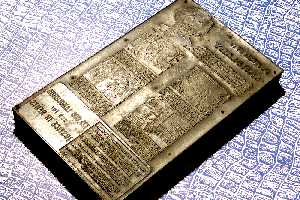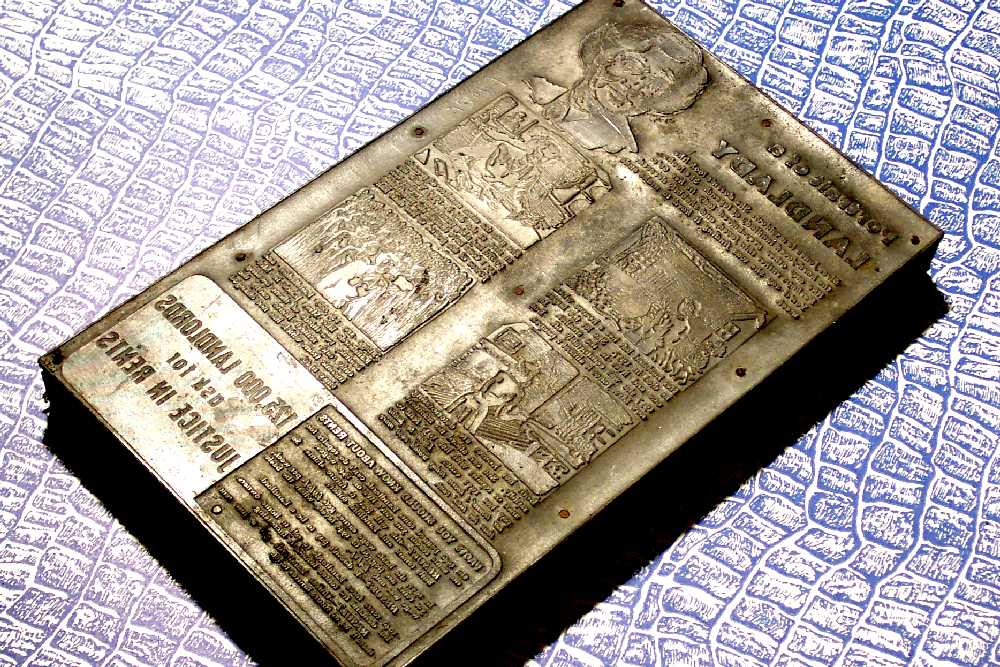
|
|
NOTE: ALL TEXT AND PHOTOGRAPHS ARE COPYRIGHT. All intending users please see our copyright notice page.

[picture in document]

This announcement appeals for a fair go for owners of rental accommodation and was issued in 1951 during the years of restrictions on rent increases.
The original appears to have consisted of line photoengravings from artist's pen drawings and a reversed typesetting, alongside text composed on the Linotype and headings in handset type.
Just visible, cast into the plate is a written date, not quite legible, that had obviously been pencilled onto the matrix, perhaps the intended date of publication.
This stereotype, along with thousands of others, is available in the Museum's archives for researchers to study and if necessary, print copies from.
Prior to moulding, the type and engravings would be made up with spacing to the required format and locked into a forme, as if to be printed, with one difference. For stereotyping, especially by the later, high-pressure method, wide strips of type-high steel (bearers) were placed around the typematter. These had the effect of protecting the type from excessive pressure and also provided a very visible type-high border on the plate when cast.
The early process of moulding a matrix was to tap a sheet of fine tissue paper over the typesetting, so that the paper would go down into each non-printing portion of the forme. The tapping was done with a stereotyper's brush, a wondrous item to behold. Further layers of paper of increasing stiffness were then pasted and tapped until a suitable thickness was achieved. The completed matrix was then removed and allowed to dry.
The later method, from early 20th century in some places, was to use a ready-made sheet of multi-layer paper (like a heavy board). This is known as ready made flong. Its controlled moisture content ensured it was reasonable pliable. This was placed over the forme; soft material (felt blankets or similar) were placed on top and the assembly moved into a heated moulding press. Substantial pressure (usually hydraulic) was applied and when the press was opened, the matrix was ready to be dried.
A number of mats could be made from the one forme.
To cast a stereotype plate, the dried matrix has a paper tail attached and is placed into the stereotype casting box. The box is closed on the mat and a spacing tool: molten typemetal is poured into the box, creating a plate with exact replication of all the type and engravings, even the fine dotwork of half-tone photographs.
A number of plates could be made from the one matrix.
Each stereotype plate would then need to be backplaned to get exact height, the borders trimmed off, then pinned to a block (as in this example) or otherwise attached to material in the printing forme.
The invention of the rotary newspaper press required the newspaper pages to be in the shape of semi-cylinders. The pages, composed in the usual way as flat formes were stereotyped; the mats were dried in a curved drier and cast in a curved casting box to produce the required shape of plate.
|
|
| What's your Interest? GO DIRECT FROM HERE OR USE OUR INDEXES BELOW |
Typography & Design__ |
D.T.P. or_ Word Proc |
Book___ History__ |
Media &_ Editing__ |
Self____ Printing |
Print___ Making_ |
Letterpress Freak____ |
|
Home___ Page____ |
Rejoin__ Tour__ |
Typo____ Glossary |
Museum___ Collections |
Museum__ Programs_ |
About the_ Museum__ |
Links__ Page__ |
Real Type Foundry_ |